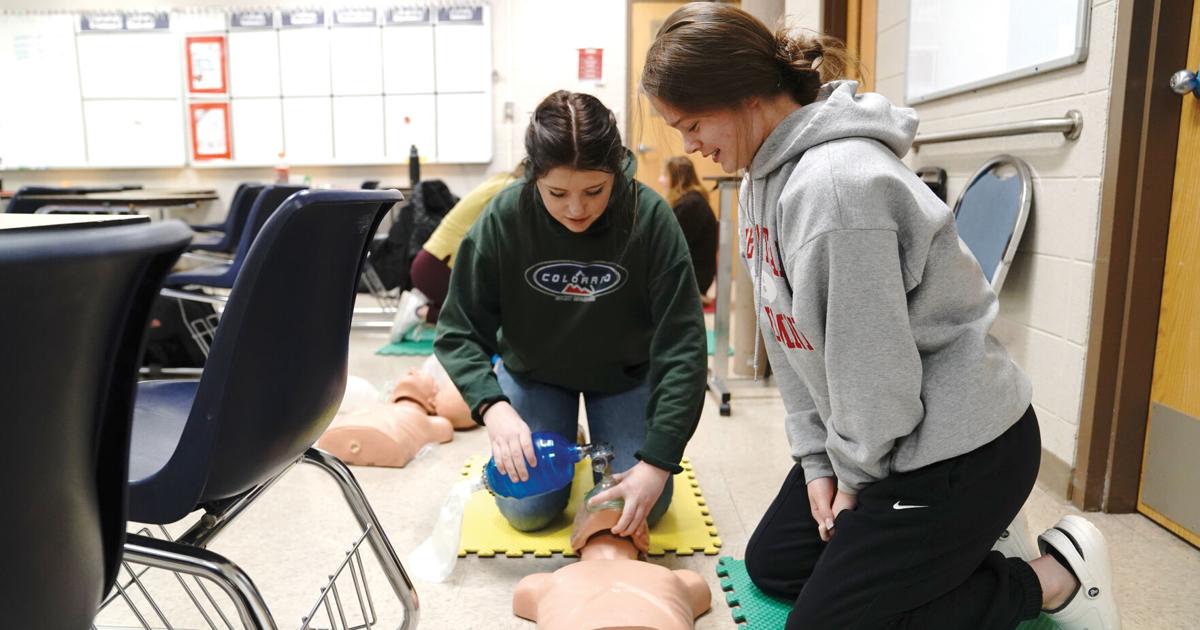
SHERIDAN — The desire to care for people is what makes any job in the health care field worthwhile, Traci Eisenman said, a health science teacher at Sheridan High School. Personal care and home health aides outpace the growth for any other field with a projected 33% growth between 2020 and 2030, even toppling health care occupations projected at 16% growth, according to the U.S. Bureau of Labor Statistics.
The increasing need for health care workers is receiving a boost from SHS efforts through three class offerings: Intro to Health Occupations, Certified Nursing Assistant and Emergency Medical Responder, helping students prepare for careers or college by the time they receive their high school diplomas. Health science courses are part of the career technical education course pathways at SHS, which gives students a foothold in the workplace or higher education by partnering with Sheridan College and local business internships.
Students discovering their interests are also exposed to a broad idea of the medical field in Intro to Health Sciences.
“In Intro to Health Sciences, we cover every opportunity. Say if you want to be a phlebotomist or a pharmacy tech, that can be on-the-job training; you don’t have to go to school. I make sure I cover all careers. Careers that require on-the-job training all the way up to cardiac surgeon,” Eisenman said.
Before COVID-19, students in this class toured Sheridan Memorial Hospital to see the world beyond the front desk and see behind the scenes of radiology and pathology. They could explore the hospital’s labs, where tests are carried out on clinical specimens to aid in diagnosis, treatment and prevention of disease.
Students witnessed a cardiac catheterization lab, also known as a cath lab, where staff used special equipment to see arteries and check how well blood is flowing to and from the heart. This type of lab performs minimally invasive tests to diagnose and treat cardiovascular disease as well.
As students explore the different health-related fields, they also build a solid foundation for basic autonomy and physiology. These classes prepare students for EMT courses or a future college career, Eisenman said.
The EMT class teaches students how to respond to medical emergencies, which includes trauma, cardiac and airway issues. This class is a step below EMT and can help students on their path to receiving an Emergency Medical Response Certificate or taking dual enrollment courses at Sheridan College. At the end of the semester, students have the option to take an EMR state certification.
Abby Walton, a teaching assistant for Eisenman, said she found the EMT classes to not only have helped her in her college EMT courses, but any emergency situation.
“Being out in the general public all the time, in case an emergency was to happen, I can help that person before the ambulance arrives,” Walton said.
Students can take a CNA class that teaches them introductory nursing concepts and basic life support. At the end of the CNA class, students have the option to take a written CNA state certification test.
“If a student knows they want to be in a nursing program, they have a head start. A lot of programs are requiring CNA,” Eisenman said.
CNA is usually considered an entry-level job, meaning many students, after completing the certification, can enter the workforce with the training learned through the class. A CNA job is a great stepping stone to other health care professions and can help students prepare for nursing or health care management work, Eisenman said, and is great at exposing students to the idea of patient care.
“I think it’s a challenge with teenagers. I don’t think they understand, when we talk about a patient that is not capable of taking care of themselves, they’re being put in these situations they’ve really never seen before. I think it opens their eyes to, ‘Wow, I can make a difference in someone’s life,’” Eisenman said.
“It gets students motivated to come to school. They want to go to woodshop, they want to get their welding certificate, they want to try these other things. This gets them excited for what’s next in their lives,” Eisenman said of the SHS CTE courses.
Walton has found great use for her CNA classes through her two-year internship with Sheridan Physical Therapy that she works at before attending classes in the morning.
“We learn a lot about fall risks and how to help people in that situation. Typically we work with an older audience down at Sheridan Physical Therapy, and if they do happen to be a fall risk, I’m already trained in helping them use gait belts and being able to respond to emergency situations,” Walton said.
Walton was also able to practice her skills in her internship as an athletic trainer for the SHS football team last year.
“They are a huge foundation for what I want to go into in the future. So, for example, the anatomy and physiology we took, that’s been huge when going to the college and taking my EMT class,” Walton said of the SHS CTE classes she took. “Just getting yourself out there and experiencing all these classes can definitely put you in the mindset of whether you want to do this or not.”
Walton, a senior, plans to continue her education at the University of Wyoming and pursue athletic training and physical therapy.





No comments:
Post a Comment